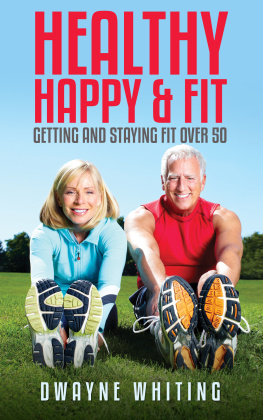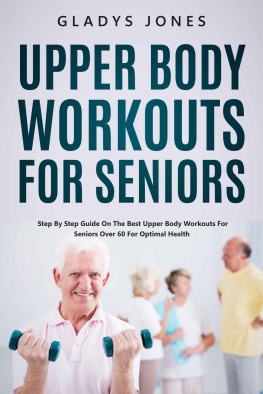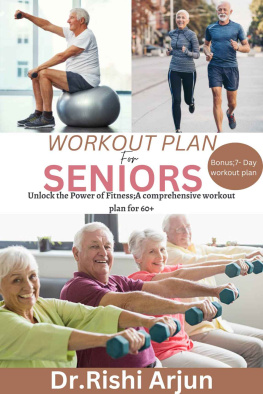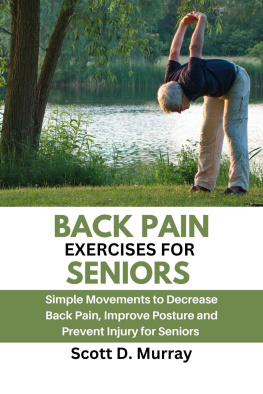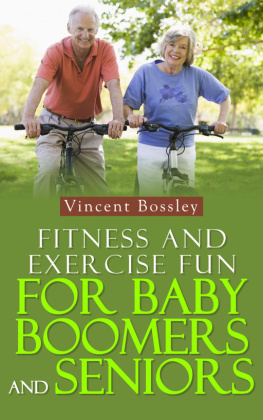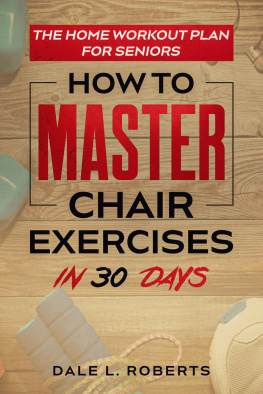Healthy Happy & Fit
Getting and Staying Fit Over 50
By: Dwayne Whiting
TABLE OF CONTENTS
PUBLISHERS NOTES
Disclaimer
This publication is intended to provide helpful and informative material. It is not intended to diagnose, treat, cure, or prevent any health problem or condition, nor is intended to replace the advice of a physician. No action should be taken solely on the contents of this book. Always consult your physician or qualified health-care professional on any matters regarding your health and before adopting any suggestions in this book or drawing inferences from it.
The author and publisher specifically disclaim all responsibility for any liability, loss or risk, personal or otherwise, which is incurred as a consequence, directly or indirectly, from the use or application of any contents of this book.
Any and all product names referenced within this book are the trademarks of their respective owners. None of these owners have sponsored, authorized, endorsed, or approved this book.
Always read all information provided by the manufacturers product labels before using their products. The author and publisher are not responsible for claims made by manufacturers.
2013
Manufactured in the United States of America
DEDICATION
This book is dedicated to my parents.
CHAPTER 1- WHAT ARE THE BENEFITS OF EXERCISING OVER THE AGE OF 50?
As people age, starting or continuing an exercise routine can be particularly challenging. However, the multitude of benefits revealed in recent studies for people over age 50 who exercise may provide the insights older adults need to start or maintain an exercise routine. In fact, research suggests even a little amount of exercise can be of value. Discover the potential benefits of exercising over age 50.
Physical Health Benefits
Reduced Risk for Chronic Illnesses
For individuals over age 50, exercise can reduce the risk of chronic diseases. A long-running study published in the Archives of Internal Medicine backs this account. The study had 18,670 men and women who turned 50 in 1984. Of those participants, the top 20 percent for fitness level at the studys inception had a lesser chance of developing any chronic illnesses than participants who placed in the nethermost fitness categories. They also had less of a chance of developing multiple chronic ailments and were older when issues arose compared to those in the lowest fitness classes.
A few of the leading conditions individuals over 50 who exercise have a reduced risk for include cardiovascular disease, osteoporosis, strokes, colon cancer and Alzheimer's disease. Such benefits are particularly encouraging as these ailments are ubiquitous in aging adults. Other acclaimed benefits of exercise for people over 50 include better bone health, favorable blood pressure, improved heart health, better immune function and enhanced digestive functioning.
Better Balance, Movement and Flexibility
Improved balance, mobility and flexibility are also among the countless benefits of exercise for adults over 50. Indisputably, inherent tightening of muscles accompanies the aging process, and numerous studies reveal that even occasional, small-impact stretches can help maintain or improve range of movement for aging adults. Exercise can help keep hips and hamstrings flexible and can reduce risk of physical injury. The types of motions built-in to many exercises contribute to better balance, which reduces the risk of falling.
Improved Posture
Adults starting an exercise routine after 50 can also improve their posture. Well-documented studies show various exercises and stretches can relieve the tension and stiffness in joints and muscles to help a persons body realign. Individuals can sit and stand taller and avoid curvature conditions, such as a hunchback and rounded shoulders.
Better Weight Management
Metabolism naturally wanes with age, but lifestyle also influences metabolism. For adults starting an exercise routine after 50, exercise can help them not only prevent excess weight gain but also help maintain weight loss. Physical activity helps boost metabolism, helps burn calories and helps build muscle mass. A sedentary lifestyle does the reverse, increasing the odds of becoming overweight and developing several chronic ailments. Regular yet simple measures like walking and taking the stairs can yield positive results for adults over 50.
In many ways, the relationship between exercise and energy is interdependent. Exercise boosts energy levels, endurance and muscle strength so that aging adults can do things like shopping, mowing the lawn, playing with grandchildren and other deeds sans becoming winded. As such, the physical benefits of exercise are boundless and circuitous.
Mental Benefits
Improves Mood and Self-Esteem
Exercising over the age of 50 accompanies several mental and emotional benefits. First, physical activity stimulates the production of endorphins. Stimulation of endorphins and other brain chemicals help trigger a positive reaction in the body, reducing feelings of sadness and depression. Those who exercise may also feel more at ease.
Moreover, the visible benefits of exercise, such as maintaining a healthy weight and appearance, can bolster confidence. Likewise, the independence gained through exercising can contribute to higher levels of self-confidence.
Enhances Brain Power
While some things do get better with age, the brain is not necessarily one of them. Deterioration of the brain is often an insidious phenomenon; exercising after the age of 50 aids in regulating brain function and brain activity. This slows down the onset of memory loss, cognitive decline and dementia. Recent studies even show that regular exercise can delay the development of Alzheimers disease. Exercise, in general, can improve a host of brain-related functions, such as hand-eye coordination and reaction time reflex. Unmistakably, exercise has serious implications for achieving overall wellness over age 50.
Battles Chronic Insomnia and Improves Sleep Quality
In a 16-week long study, researchers at Northwestern University found that aerobic exercise, such as riding a stationary bicycle, walking or exercising on a treadmill, can help individuals over the age of 50 combat insomnia and improve overall sleep quality. They studied 23 sedentary adults, men and women aged 55 years and older. These participants previously reported difficulty falling asleep and weakened daytime functioning.
For the purposes of the study, members were placed arbitrarily in one of two groups. At completion of the study, not only did the participants who exercised report that their sleep quality improved, they also reported less drowsiness during the day and fewer depressive symptoms. Notably, the members of the other group who only exerted themselves mentally by participating in educational or recreational activities, such as listening to a museum lecture or attending a culinary lesson, did not have a positive turnaround.
Improves Life Quality
The benefits of exercise are so pervasive that some of the benefits are interspersed in unquantifiable ways in a person's life. At its core, exercise helps to improve the quality of life for people over 50. From living longer and promoting optimism to improving self-image, improvements in life quality vary widely and immeasurably.
In essence, exercise can help individuals over 50 obtain a quality, deep nights rest, and given that sleep deprivation and untreated sleep disorders have serious health implications, such as decreased performance and alertness, obesity, heart failure, memory and cognitive impairment, for any age group, it is especially important for aging adults to sleep well and sufficiently.

